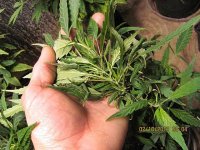Are broad mites and russet mites the same??
Nope, they are not
Hemp Russet Mite - Aculops cannabicola
Broad Mites= Tarsononemid mites
Are broad mites and russet mites the same??
Nope, they are not
Hemp Russet Mite - Aculops cannabicola
Broad Mites= Tarsononemid mites
hey daheadies,
her's a pic of what russet mite damage looks like.
Are there any mites on that picture? If so would you please indicate their location? Thanks.
Pine
I found this, its cheap and its on a very low order of toxicity
kills mites and their eggs... Volck oil spray
$6 for a pint bottle and makes quite a bit from that.
when i 1st started growing and had to deal with some mites an old hand recommended it.
its been used for years in the nursing/orchard industry.
we'll see what it does to the broads
avid is on the way.
so thats whats instore for dem broads till the avid gets here.
i'll let everyone know how the volck oil spray pans out.
well I doused the plants with volck oil 2 days ago and I still have BMs
volck oil didn't seem to phase them at all
mark my words, the Broad Mite is going to be the next BIG problem in the cannabis community...and in 3 years from now, it will be a common pest in our scene
hey mrdank,
I'm surpised they haven't already created kaos with peeps in the cut scene...
Dank, I think your 3 year estimate is way off...this is problem is ravaging crops today, not tomorrow.
Gnome, I talked to a well known vendor in the bay area recently. I had described the symptoms of this new pest to him and he had some plants that were exhibiting the signs. After spraying them with Forbid, they regained their vigor in a week. He didn't see the bugs (he has poor vision) but it certainly seems he had this plague. With prominent clone vendors reporting from San Diego, LA, and Berkeley all distributing the bugs, I'm pretty sure this is a widespread epidemic as of today.
This is an Old Testament type of problem...those hoards of locust were the enemy back in the day, this year people will be saying 'God, I wish I had spider mites instead of these broad mites...' Please tell every grower you know about them and have them spread the word.









Q, does forbid kill the eggs?
I think avid does but not sure about forbid.'
friend of mine hit his with forbid but still had a few live ones days later,
I'm thinking it may have been new mites hatchlings
on another note i had a small plant infested with the broads and tented it in a large trashbag overnite with a NPS, next day I looked for 10 minutes and couldn't find one live mite, I hit it with avid anyways to deal with the eggs